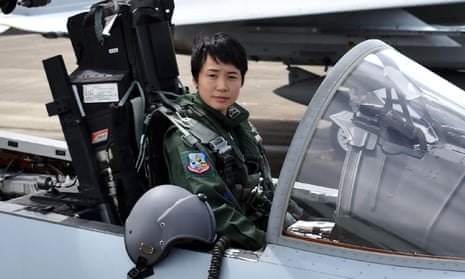Misa Matsushima had dreamed of taking to the skies ever since she watched Top Gun as a young girl. On Friday the 26-year-old realised her dream and struck a blow for Japan’s women when she started duty as the country’s first female fighter pilot.
Matsushima, who holds the rank of first lieutenant in the air self-defence force, completed her training this week, just three years after Japan lifted its ban on women becoming fighter pilots.
“I have admired fighter jet pilots ever since I saw Top Gun when I was in primary school,” she told reporters on the eve of starting her new role. “I want to continue to work hard to carry out my duties, not just for myself but also for women who want to follow this path in the future.”
Three other women are training to join Japan’s elite group of fighter pilots.
Matsushima, who obtained her pilot’s licence two years ago, has been assigned to the air self-defence force’s 5th air wing at Nyutabaru air base in the southern prefecture of Miyazaki, where she will spend the next six to 12 months learning to fly F-15 fighters.
Japan’s air force relaxed gender-based restrictions on a host of roles in 1993 but continued to allow only men to pilot fighter jets and reconnaissance aircraft.
Matsushima, a graduate of Japan’s National Defence Academy, initially planned to fly transport planes but set her sights on becoming a fighter pilot as soon as the gender restrictions were lifted in late 2015, as part of prime minister Shinzo Abe’s mission to create more work opportunities for women.
Earlier this year Ryoko Azuma became the first woman to command a warship squadron as Japan’s navy attempts to make up a shortfall in personnel caused by the dwindling population of working-age people.
Azuma now commands four vessels, including the flagship helicopter carrier Izumo, and a combined crew of 1,000 – only 30 of whom are women.
“I don’t think about being a woman. I will focus my energy on fulfilling my duties as commander,” Azuma said after her appointment in March.
When she joined Japan’s maritime self-defence force in 1996, women were still barred from serving on warships. While the ban was lifted a decade ago, women are still not permitted to serve on submarines.
There are currently just 14,000 women – or 6% of the total – among Japan’s 228,000 service personnel. The self-defence forces plan to increase the number of women serving in the air, sea and ground forces to 9% by 2030.
“I hope she continues to follow this difficult path and become a role model for women who aspire to become fighter pilots,” Matsushima’s former instructor, Osamu Uemori, told Kyodo news.
